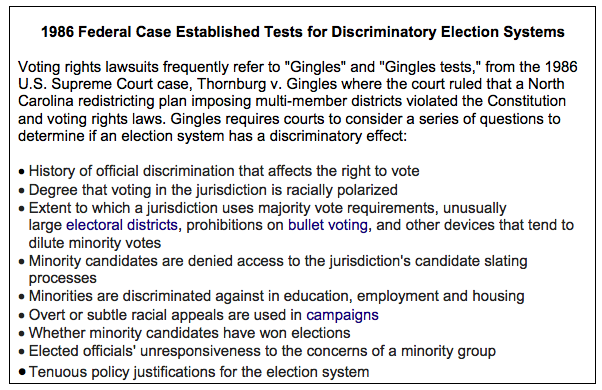Santa Clara County Superior Court Judge Thomas Kuhnle said that he will issue a “proposed statement of decision” in the California Voting Rights Act (CVRA) lawsuit against the City of Santa Clara around May 15 and a final ruling after the June 5 special election.
The proposed statement of decision isn’t binding, and attorneys in the case will have two weeks to file objections. “This is a hard case,” said Kuhnle after the four-day trial. “Both sides have raised novel issues.”
If a violation is found, the “remedy phase” will be fast-tracked to complete by the end of July. The judge may accept the proposed 2×3 Ranked Choice Single Transferrable Vote system as a remedy if the he rules that the City violated the CVRA, but he can also recommend a different solution.
Dueling Statistics
The first days of the trial were largely devoted to statistics. Plaintiff’s expert Morgan Kousser, Ph.D. found “robust evidence” of racial polarization after analyzing City elections since 2002.
“The most important fact, ascertained without any statistical analysis whatsoever, is that all of the Asian-American candidates lost,” he wrote in his testimony.
“All of the winning candidates in these 10 contests were non-Hispanic whites, and 6 of them were incumbents or former members of the Council, which put Asian-American hopefuls at even more of a disadvantage,” he continued. “Five of the contests were racially polarized by each of three statistical methods.”
In his report the City’s expert witness, Jeffrey Lewis, Ph.D., disputed that any such findings could be made where there wasn’t a geographical concentration of minorities.
Lewis studied only the 2016 City Council elections and concluded that, “The manner in which Asian and non-Asian voters are distributed across precincts in the City of Santa Clara precludes reliable inferences about the support for various candidates for City Council among Asian voters.”
If there were polarized voting, Lewis wrote, Raj Chahal “would have prevailed if 3 in 10 of the 59 percent of Asian voters who did not support him [by Lewis’ inferences] had done so.”
Because it’s not possible to know how individuals actually vote, identifying racially polarized voting and minority vote dilution depends on several levels of analysis.
The first is looking at election precincts and identifying demographics from statistical information that is available—for example, last names and census data. The second is looking at the vote totals from each precinct and using three different statistical modeling methods (regression analysis) to identify voting patterns for different groups.
The City’s attorney Thomas Churchwell disputed the validity of the modeling methods when applied to heterogeneous populations instead of homogeneous populations.
Plaintiff’s attorney Maurice Baller dismissed this objection as illogical, saying, “The CVRA doesn’t say ‘segregated cities [only] are subject to this [CVRA] act.’ If you can’t use the only method to show racially polarized voting, there would be no way to apply the statute.”
The plaintiff’s attorneys repeatedly returned to one fact that required no statistical analysis: the fact that no Asian has ever been elected to Santa Clara’s City Council. “That doesn’t depend on the strength of the model,” said Baller. “That’s history.”
The second arena of contention was the sociological: whether Santa Clara’s all-white City Council reflects a deeper bias that can be shown according to “Gingles tests” named after a U.S. Supreme Court voting rights case, Thornburg v. Gingles. These are, said the plaintiff’s attorney Robert Rubin, “an evaluation of past and present realities.”
One of those “realities” is the anti-Asian bias in California and U.S. history—from the Chinese Exclusion Act to Japanese internment during WWII—as well as the more local and recent controversy over naming part of El Camino Real “Koreatown.”
The second “reality” is what the trial brief called “curious” and “unexplained” changes to a 2011 demographer’s report between its first draft and its final version. The first version of the report included several strong statements to the effect that Santa Clara was vulnerable to a CVRA lawsuit. Later versions toned down these statements and deleted some of them altogether. The Weekly asked for comment from the author of the report, demographic firm Gobalet and Lapkoff, but received no response as of press time.
The third is that, faced with the opportunity to fill a City Council vacancy created by Lisa Gillmor’s appointment as mayor in 2016, instead of selecting from several well-known Asian applicants for the position, the City Council appointed another white woman.
Defense attorney Steven Churchwell answered that the Koreatown question had “nothing to do with civil rights” and that “the position of Asian-Americans in Silicon Valley” wasn’t comparable to the barriers preventing African-Americans from voting at all in the segregated South. “It hasn’t met the standard,” said Churchwell. “That should be it.”
In the discussion of the demographer’s draft report, Judge Kuhnle asked, “Can I treat this as an admission by the City that there was a problem?”
“I don’t want to address that,” replied Churchwell. Instead, he pointed out that the City was open about publishing the draft report on the City’s website and was making changes to its election system.
Wesley Mukoyama, one of the people who brought the voting rights lawsuit, seemed less interested than the lawyers in the fine points of legal maneuvering or statistical models. The history is clear, he said.
“I’ve lived here 44 years and I have never seen a minority on the City Council. “The Gillmors have been there for ages,” he said. “They just change position, they just shift the chairs.”
If the City didn’t think at-large voting was discriminatory, he continued, why put forward the current proposal to create two districts? “They’re trying to retain the positions they have.” The right thing, Mukoyama said, is six single-member districts.
